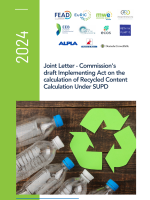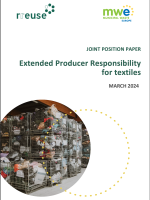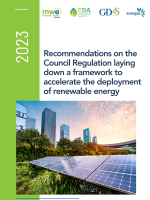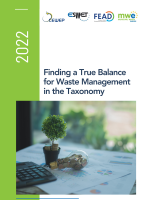Joint Statement on the establishment of a framework to facilitate sustainable investment
The undersigning associations note with great concern that the Commission's proposal for a regulation establishing a framework to facilitate sustainable investment (also known as "taxonomy"), lists activities like "avoiding incineration and disposal of waste" as sustainable (Art.9.1.i), while activities that "[lead] to a significant increase in the generation, incineration or disposal of waste" (Art. 12.d) are considered as harming environmental objectives.
For waste that contains substances of concern and therefore cannot be recycled in an environmentally sound way, incineration is the only sustainable option. It destroys these substances and prevents pollutants being spread into the environment.
Sustainable investments should follow the integrated approach to waste management while respecting the waste hierarchy. As indicated in Article 4 of the Waste Framework Directive, lifecycle thinking should be taken into consideration when applying the waste hierarchy, in order that the most environmentally sustainable waste management option is selected. This means beginning with product eco-design and in the waste phase, selecting the reuse or recycling option which will make the best use of material resources, followed by the recovery of energy from these resources once they are no-longer recyclable or reusable. Landfilling is the last resort for waste that cannot be recovered.
Europe needs an integrated waste management approach complete with the appropriate and sustainable interaction of reuse, quality recycling, efficient energy recovery and environmentally sound disposal of waste that cannot be recovered. In order to achieve high recycling rates with low landfill rates, the whole waste management system from communication and collection to treatment of the residual fraction must be carefully designed and executed. Only with such a holistic process, can effective waste management which prevents environmental degradation, protects human health and generates recovered raw materials and energy to feed a circular economy succeed.
It is also important to note that the most virtuous countries (in terms of recycling) achieved their results with national policies oriented towards an integrated approach in waste management. This included, apart from efficient landfill diversion, a sound planning of treatment capacity for the residual waste that cannot be recycled. This capacity is still lacking in some Member States. If there is no outlet for residual waste, the materials cycle runs the risk of contamination with pollutants ending up in products, on uncontrolled landfills or open fires (appearing more frequently since China and other Asian countries restricted their policy on waste import); causing immeasurable damage to human health and the environment.
The Waste-to-Energy incineration sector deals with mixed materials that are difficult to recycle or materials that are degraded after several cycles of recycling (e.g. EU paper fibres are used 3.6 times on average (highest in the world) while the paper industry calculated that 22% of all paper products are impossible to collect or recycle). This is how Waste-to-Energy helps recycling by taking care of the degraded materials that cannot be used anymore as quality recyclates.
Waste-to-Energy preserves the value of this residual waste in the economy by transforming it into electricity and/or heat (mostly in efficient cogeneration) under strictly controlled conditions, preventing resource losses, decreasing the need for fossil fuels, increasing energy security and reducing greenhouse gas emissions. As EU Member States are drafting integrated energy and climate change plans, looking to phase-out inefficient and polluting coal-fired power plants, taking these dimensions into consideration is essential to making the bridge between the circular economy, energy union and climate change objectives.
For this reason, in order to ensure that the framework for sustainable investment does not prevent necessary investment in residual waste treatment which completes an integrated and sustainable waste management system, the undersigning associations suggest the following amendment:
Article 9.1 | |
Commission Proposal | Amendment Proposal |
An economic activity shall be considered to contribute substantially to the transition to a circular economy and waste prevention and recycling where that activity contributes substantially to that environmental objective through any of the following means: [...] (i) avoiding incineration and disposal of waste; | An economic activity shall be considered to contribute substantially to the transition to a circular economy and waste prevention and recycling where that activity contributes substantially to that environmental objective through any of the following means: [...] (i) avoiding waste management options that are not in line with the waste hierarchy as set out in Article 4 of Directive 2008/98/EC and reflected as such in the national waste management plans in accordance with Article 28 of Directive 2008/98/EC; |
Article 12 | |
Commission Proposal | Amendment Proposal |
(d) circular economy and waste prevention and recycling, where that activity leads to significant inefficiencies in the use of materials in one or more stages of the lifecycle of products, including in terms of durability, reparability, upgradability, reusability or recyclability of products; or where that activity leads to a significant increase in the generation, incineration or disposal of waste; | (d) circular economy and waste prevention and recycling, where that activity leads to significant inefficiencies in the use of materials in one or more stages of the lifecycle of products, including in terms of durability, reparability, upgradability, reusability or recyclability of products; or where that activity leads to a significant increase in the generation of waste or to an unjustified deviation from priorities of the waste hierarchy as set out in Article 4 of Directive 2008/98/EC; |
Justification | |
As indicated in Article 4 of the Waste Framework Directive, life-cycle thinking should be taken into consideration when applying the waste hierarchy, in order to choose the most environmentally sustainable waste management option. For waste that contains substances of concern and therefore cannot be recycled, incineration is the only sustainable option to destroy them and to avoid spreading pollutants into the environment. The original proposal puts recovery (Waste-to-Energy) and disposal operations on an equal footing while Waste-to-Energy results in waste serving a useful purpose. | |
Ella Stengler, Managing Director, Confederation of European Waste to Energy Plants
CEWEP is the umbrella association of the owners and operators of European Waste-to-Energy Plants.
www.cewep.eu
Hans Korteweg, Managing Director, COGEN Europe, the European Association for the Promotion of Cogeneration, is the cross-sectoral voice of the cogeneration industry.
www.cogeneurope.eu
Paul Voss, Managing Director, Euroheat & Power
Euroheat & Power represents the District Heating sector in Europe.
www.euroheat.org
Patrick Clerens, Secretary General, The European Suppliers of Waste-to- Energy Technology. ESWET is the European Association representing manufacturers in the field of Waste- to-Energy technology.
www.eswet.eu
Vanya Veras, Secretary General, Municipal Waste Europe
Municipal Waste Europe is the European umbrella association representing public responsibility for waste.




